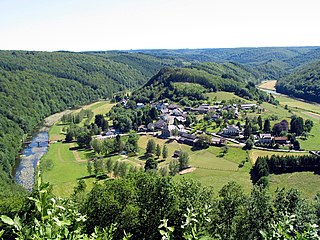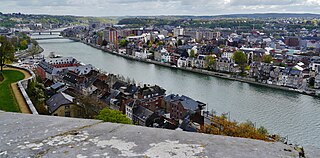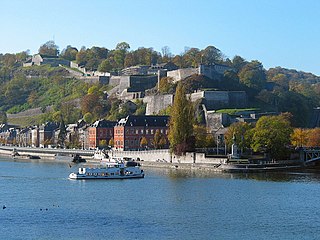
The Meuse or Maas is a major European river, rising in France and flowing through Belgium and the Netherlands before draining into the North Sea from the Rhine–Meuse–Scheldt delta. It has a total length of 925 km.

The Ardennes, also known as the Ardennes Forest or Forest of Ardennes, is a region of extensive forests, rough terrain, rolling hills and ridges primarily in Belgium and Luxembourg, extending into Germany and France.

Dinant is a city and municipality of Wallonia located in the province of Namur, Belgium. On the shores of river Meuse, in the Ardennes, it lies 90 kilometres (56 mi) south-east of Brussels, 30 kilometres (19 mi) south-east of Charleroi and 30 kilometres (19 mi) south of the city of Namur. Dinant is situated 20 kilometres (12 mi) north of the border with France.

Namur is a city and municipality in Wallonia, Belgium. It is the capital both of the province of Namur and of Wallonia, hosting the Parliament of Wallonia, the Government of Wallonia and its administration.

Namur was a county of the Carolingian and later Holy Roman Empire in the Low Countries, a region in northwestern Europe. Its territories largely correspond with the present-day French-speaking Belgian arrondissement Namur together with the northwestern part of the arrondissement Dinant, which are both part of the modern province of Namur. The modern provincial boundaries are based on the French Republican department of Sambre-et-Meuse.

The Lesse is a river in the Ardennes, in the Walloon region of Belgium. It is a right tributary to the river Meuse.

The Citadel of Namur is a fortress in the Walloon capital city of Namur, at the confluence of the Sambre and Meuse rivers. It is originally from the Roman era, but has been rebuilt several times. Its current form was designed by Menno van Coehoorn, and improved upon by Vauban after the siege of 1692. It has been classified as a Wallonia Major Heritage site. Its highest point sits at 190 metres (620 ft). Together with those at Dinant, Huy and Liège, the Citadel of Namur forms part of the so-called Meuse Citadels.

The Castle of Freÿr with its gardens in the style of Le Nôtre is located in Wallonia on the left bank of the Meuse, between Waulsort and Dinant. They form one of the most magnificent natural sites in Belgium. It has been classified as one of Wallonia's major heritage sites. It is often called a greatly reduced Versailles. Originally a Renaissance castle, it was extended in the 18th century and was once the residence of dukes and their royal guests. It has gardens including orange trees. The more than three-hundred-year-old orangeries are the oldest in the Low Countries.

The Condroz is a natural region in Wallonia, the French-speaking part of Belgium, located between the Ardennes and the Meuse. Its unofficial capital is Ciney. The region preserves the name of the Condrusi, a Germanic tribe which inhabited the area during and before the Roman era.

Crèvecœur Castle is a ruined castle in Belgium. The ruins of the Château de Crèvecœur are located in Bouvignes-sur-Meuse, part of the Belgian city of Dinant, province of Namur, Wallonia. The castle is owned by the Walloon Region. The ruin field can be visited freely all year.

Dave Castle, also known as Fernan-Núñez Castle is a château in the village of Dave, Wallonia, also known as Dave-sur-Meuse, now a part of the city of Namur, Belgium.

Walzin Castle is a castle in the city of Dinant, Wallonia Belgium in the province Namur over the river Lesse, district of Dréhance. This Gothic Revival castle stands on a steep rock above the right bank of the Lesse, about 5km before it flows into the Meuse. Popular kayak routes allow a view of the castle from the Lesse Valley.

The Battle of Lambusart saw a Republican French army led by Jean Baptiste Jourdan try to cross the Sambre River against a combined Dutch and Habsburg Austrian army under William VI, Hereditary Prince of Orange. This battle was the culmination of the fourth of five attempts to consolidate a foothold on the north side of the Sambre. The clash occurred during the War of the First Coalition, part of a wider struggle known as the Wars of the French Revolution. In 1794, Lambusart was an independent village, but it is now part of the Fleurus municipality. Lambusart is located about 10 kilometres (6 mi) northeast of Charleroi.

The Battle of Dinant was an engagement fought by French and German forces in and around the Belgian town of Dinant in the First World War, during the German invasion of Belgium. The French Fifth Army and the British Expeditionary Force (BEF) advanced into Belgium and fought the Battle of Charleroi (21–23 August) and Battle of Mons (23 August), from the Meuse crossings in the east, to Mons in the west. On 15 August 1914, German troops captured the Citadel of Dinant which overlooked the town; the citadel was recaptured by a French counter-attack during the afternoon.

St Anne's College was one of the colleges of Leuven University, now listed as built heritage of Flanders, Belgium.
Auxbrebis, originally also written as A Brebis when recognized as échevins (Alderman) and Patrician thereafter as aux Brebis, is an old noble family name. The name has been attested as early as in the thirteenth century. They are illustrated as originating from the city of Dinant as merchants and copper beaters.

Anseremme is a village of Wallonia and a district of the municipality of Dinant, located in the province of Namur, Belgium.

The Rocks at Freÿr form a large rock mass on the right bank of Meuse, between Waulsort and Anseremme in. Its walls of varying gradients and roughness make it a privileged climbing place in Belgium. The site is listed in the Wallonia's Major Heritage and the Natura 2000 network

The Sack of Dinant or Dinant massacre refers to the mass execution of civilians, looting and sacking of Dinant, Neffe and Bouvignes-sur-Meuse in Belgium, perpetrated by German troops during the Battle of Dinant against the French in World War I. Convinced that the civilian population was hiding francs-tireurs, the German General Staff issued orders to execute the population and set fire to their houses.

The German atrocities of 1914 were committed by the Imperial German Army at the beginning of World War I in Belgium, particularly in Wallonia, and in France in the departments of Meuse, Ardennes, and Meurthe-et-Moselle.




















